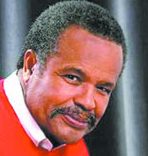Black Arts and Culture
A Review: Expecting Something Bigger

By Terrance Afer-Anderson
Arts & Culture Columnist
New Journal and Guide
John Biggers (1924-2001), a native of Gastonia, North Carolina, was a celebrated African-American muralist, painter, illustrator, sculptor, and educator, who rose to prominence in the wake of the Harlem Renaissance.
Following his father’s passing from Diabetes in 1937, his mother enrolled young Biggers at Lincoln Academy, a private boarding school in King’s Mountain.
Biggers worked as a janitor at the academy to help cover the cost of tuition. This might have led to his occasional pre-occupation with the industrial arts, when life as a young African-American male seemed daunting, when dreams to live, equally, as an ordinary American, seemed elusive.
Yet, as fortune would have it, upon Biggers’ graduation from Lincoln in 1941, he enrolled at Hampton University, then Hampton Institute, where he met art professor Viktor Lowenfeld. A Jewish refugee who lost his family to the holocaust, Lowenfeld had convinced Hampton president Malcolm Shaw Maclean to allow him to create an Art Department at a school more noted for agriculture, the industrial arts and education.
Amongst his first students were Biggers and fellow classmate Samella Sanders. This is the where Jacqueline E. Lawton’s insightful drama The Hampton Years, the current Virginia Stage Company production, begins.
The hallmark of Biggers’ work is his colorful celebration of African and African-American culture. Lawton treats us to his early development, interest and forays in that genre; emboldened by the passionate instruction and encouragement he received from Lowenfeld, to be unabashed in expressions of his truth, his inner voice, his soul. The aspiring artist quickly learned though that major art institutions would not embrace what they often perceived as brash social commentary. Moreover, most felt that African-American art and artists were of little consequence, no merit.
In an effort to generate keen interest in his fledgling Art Department, Lowenfeld made a bold move and arranged for a 1943 exhibition of his students’ work at New York’s famed Museum of Modern Art. Entitled Young Negro Art, the exhibit featured Biggers’ mural Dying Soldier. It was dismissed by the press as “screaming propaganda.”
Fellow Art professor and award-winning artist Elizabeth Catlett had warned, even chided, Lowenfeld about the perils of showing his African-American students work in such a grand forum. Though a successful award-winning artist, her own work had not always had benefit of pristine, unprejudiced acceptance. She was well aware that the majority American populace were confused, even made uncomfortable, by the Black creative voice.
This is the central theme of Lawton’s drama, that African-American art, especially the dramatic ilk of the potent, vibrant imagery that Biggers sculpted with brush strokes on canvas, provides a distinctive, essential voice in portraits of American culture. As both Lowenfeld and Catlett asserted, Black art should be truth, pure and unencumbered, unfettered expressions that come directly from the African-American experience. This is where this VSC production falters.
Though blemished by occasional aberrant behavior and acts of utter stupidity, the relationship between Jewish-Americans and African-Americans has oft been defined by vitality and resourcefulness. Blacks have greatly contributed to Jewish-American commerce and Jews were often on the frontline in demonstrations for U.S. Civil Rights. Lawton’s play paints a compelling illustration of how each group struggled to understand the unique challenges of the other, but The Hampton Years begs chiefly to tell the story of John T. Biggers. It needed to be in the hands of a director intimately, personally, acquainted with the African-American experience.
Director Chris Hanna is a seasoned, gifted artist with impeccable credentials. I have been uniformly impressed with his work and am a genuine fan. I am additionally a fan of non-traditional casting and certainly believe that artistic opportunity should not be limited by ethnic bearing. But, in Hanna’s hands, some of Lawton’s dialogue appears stilted and terribly cliché. Similarly, there are moments when the characterizations, across racial boundaries, feel as though they toady to stereotype.
Still, if even for the history lesson alone, this production of The Hampton Years is worth the price of admission. There are performances embedded within that are quite noteworthy.
As Biggers, W. Tre’ Davis offers up a solid portrait of a passionate, complicated artist who refuses to surrender his values, his voice, for sake of a complacent career. Adam Greer succeeds in his portrayal of Lowenfeld, a well-intentioned professor-mentor, genuinely enamored with African art and peoples, but naïve to the strident institutional racism that permeates his world.
As Sanders, Meredith Johnson’s performance is much on the surface, burdened by free-wheeling caricature and a lack of depth. Chandra Thomas, as Catlett, had numerous very nice moments, but she too was also given to topical treatments. Eric Harrell’s portrayal of Maclean was compact, trim and neat, yet somehow not leaving much room for subtlety.